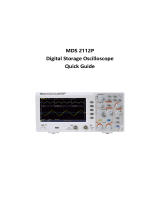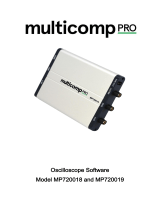Page is loading ...

User Manual
SHS800 Series Handheld Digital Oscilloscope
UM03008-E05A
SIGLENT TECHNOLOGIES CO,.LTD


SHS800 Series I
Declaration
1. Copyright © SIGLENT TECHNOLOGIES CO., LTD.
2. Information in this manual takes place of all data published before.
3. SIGLENT company reserves the rights to change specifications and price.
4. Contents in this manual are not allowed to be copied, extracted and
translated without permission by the company.

II SHS800 Series
Safety Information
Carefully read the following safety information before using the SHS800.
Specific warning and caution statements, where they apply, appear throughout the
manual.
A “Warning” identifies conditions and actions that pose hazard(s) to the user.
A “Caution” identifies conditions and actions that the user should notice.
The following international symbols are used on the SHS800 and in this manual:
Hazardous Protective Warning Earth Ground Power
Voltage Earth Ground Switch
Use only insulated voltage probes, test leads and adapters supplied
with the SHS800, or accessories appointed by the company.
Before use inspect voltage probes, test leads and accessories for
mechanical damage and replace when damaged.
Always connect the battery charge first to the AC outlet before
connecting it to the SHS800.
Do not apply voltages that higher than 600 V from earth ground to any
input when using scope ports in a CAT Ⅲ environment. Do not apply
voltages that higher than 1000 V from earth ground to any input when
using scope ports in a CAT Ⅱ environment.
Do not apply input voltages above the rating of the instrument. Use
caution when using 1:1 test leads because the probe tip voltage will be
directly transmitted to the SHS800.
Do not apply voltages that higher than 300 V from earth ground to any
input when using multimeter ports in a CAT Ⅲ environment. Do not
apply voltages that higher than 600 V from earth ground to any input
when using multimeter ports in a CAT Ⅱ environment.
Do not apply voltages that higher than 300 V from earth ground to the
isolated inputs when using multimeter ports in a CAT Ⅲ environment.
Do not apply voltages that higher than 600 V from earth ground to the
isolated inputs when using multimeter ports in a CAT Ⅱ environment.

SHS800 Series III
Do not insert metal objects into connectors.
Use of the SHS800 in a manner not specified may impair the
protection provided by the equipment. Before use, inspect the test
leads for mechanical damage and replace damaged test leads!
Whenever it is likely that the safety has been impaired, the SHS800
must be turned off and disconnected from the line power. The matter
should then be referred to qualified personnel.
Warning:
Standard probe 10:1 supports CAT Ⅱ 400V.
Optional probe supports CAT Ⅱ 1000V and CAT Ⅲ 600V

IV SHS800 Series
Safety Operation of Battery
SHS800 series handheld digital oscilloscope can be used to test float signal when
power supplied by battery. When using the double channels to test float signal, the two
channels should be connected to the same earth ground, because the earth ground of
the two channels is connected
Warning:
Do not connect the ground spring to voltages higher than 42 V peak or 30Vrms from
earth ground.
Warning:
Do not use USB line to connect SHS800 to any instruments (such as computer, printer
and so on) which connected to the earth ground, or the SHS800 and the instruments
connected with will be burned.

SHS800 Series V
Introduction of SHS800 Series
This manual mainly introduces SHS800 series Handheld Digital Oscilloscope.
The SHS800 series is a high performance handheld oscilloscope with great range of
dynamic input scope. It has small volume which convenient to carry, compact interface
and etc. It satisfies the most needs of outside measurement and improves working
efficiency greatly.
Function Characteristics
The SHS800 combines the functions of oscilloscope, multimeter and recorder
(including trend plot and waveform recorder) along with double channels.
Oscilloscope channels input voltage grade: voltage inputs directly through a
BNC probe is as high as CATⅡ 300V and CAT Ⅲ 150v.
Standard probe: 10X CATⅡ 400
Optional probe: 10X CATⅡ 1000V and 10X CAT Ⅲ 600V
Oscilloscope and multimeter safety grade is CATⅡ 600V and CAT Ⅲ 300V
5.7 inches color TFT LCD.
It provides maximal bandwidth 200MHz, real time sampling rate 1GSa/s,
memory depth 2Mpts.
The multimeter display resolution is 6000 points and can measure voltage,
current, resistance, capacitance, diode, continuity.
Support scope measure parameters trend plot, multimeter measure
parameter trend plot and scope waveform recorder.
3 types of trigger mode: auto, normal and single; 5 types of trigger type: edge,
pulse, video, slope and alternative.
32 types of auto-measurement function and 3 types of cursor measure mode.
5 kinds of digital filter mode: +, -, *, /, FFT.
Unique digital filter function and waveform recording function.
2 groups of reference waveform, 20 groups of common waveform, 10 groups
of setting inside save / recall; Support waveform, setting, CSV and bitmap file
save and recall with USB flash driver.
Standard configuration interface: USB Device, USB Host. Support software
update with USB flash driver, PC remote control and PicBridge print.
For its build-in Li battery and small volume, it’s convenient to carry and work
outside.

VI SHS800 Series
Accessories of SHS800
A user manual
A product guaranty card
A certification
Two 1:1/10:1 probes
An USB cable
A adapter
Meter pens for multimeter
A Probes calibrated device
A CD (including EasyScope3.0 computer software system)
Optional Probe
100MHz high-voltage safety probe C
A
T II 1000V,C
A
T III
600 V

SHS800 Series VII
Table of Contents
Safety Information ..................................................................................................................... II
Safety Operation of Battery .................................................................................................... IV
Introduction of SHS800 Series ................................................................................................ V
Function Characteristics ......................................................................................................... V
Accessories of SHS800 ......................................................................................................... VI
Chapter 1 Accidence .................................................................................................................. 1
Accidence of the Front Panel and User Interface .................................................................. 1
Function Check ......................................................................................................................... 4
Chapter 2 Using the Scope ....................................................................................................... 5
Menu and Control Buttons ....................................................................................................... 5
Automatic Settings.................................................................................................................... 6
CH1/CH2 Channel Functions .................................................................................................. 6
Scope’s Function Menu............................................................................................................ 9
Acquire Signals System .................................................................................................... 9
Display System ................................................................................................................ 11
Math Waveform ................................................................................................................ 13
Horizontal System ............................................................................................................ 15
Reference waveform ....................................................................................................... 17
Cursor and Measure System ................................................................................................. 18
Cursor measure ............................................................................................................... 18
Parameter Measure ......................................................................................................... 20
Trigger System........................................................................................................................ 25
Save and Recall System ........................................................................................................ 33
Utility System .......................................................................................................................... 37
Chapter 3 Using the Multimeter ............................................................................................. 43
Making DC and AC Voltage Measurement ........................................................................... 44
Making Resistance Measurement ......................................................................................... 45
Making Diode Measurement .................................................................................................. 46
Making Continuity Measurement ........................................................................................... 46
Making Capacitance Measurement ....................................................................................... 47
Making DC and AC Current Measurement ........................................................................... 48
Chapter 4 Using the Recorder Functions ............................................................................ 50
Oscilloscope Trend Plot ......................................................................................................... 51
Waveform Recorder ............................................................................................................... 54
Multimeter Trend Plot ............................................................................................................. 57
Chapter 5 Prompting and Troubleshooting ......................................................................... 60
System Prompting Messages Instruction ............................................................................. 60
Troubleshooting ...................................................................................................................... 62

VIII SHS800 Series
Chapter 6 Service and Support .............................................................................................. 64
Maintain Summary.................................................................................................................. 64
Contact SIGLENT ................................................................................................................... 64
Appendix A: Default Setup ..................................................................................................... 65
Appendix B: Battery Installation ............................................................................................ 67
Appendix C: Daily Maintaining and Cleaning ...................................................................... 6
8

SHS800 Series 1
Chapter 1 Accidence
About this Chapter
This chapter mainly covers the following contents:
Get a primary understanding of the front panel and user interface
A brief function check
Probe compensation
Accidence of the Front Panel and User Interface
You’d better get an understanding of the front panel before you operate the SHS800
series Handheld Digital Oscilloscope. The following contents introduce the function of
the front panel. With its help you could be familiar with the operations of the SHS800 in
a short time.
Figure 1-1 Front Panel
1
2
3
4
5
6
7
8
9
10
11
12
13
14
15
17
16

2 SHS800 Series
Description
1. power on/off key
2. CH1 vertical range and position key
3. CH1 on /off key
4. Scope, Meter, Recorder function
menu
5. option keys
6. Handle
7. LCD
8. LOGO
9. BW and sample rate
10. menu on/off key
11. arrow keys
12. Auto, Run/Stop, Cursor function
keys
13. CH2 on/off key
14. Trigger, User, Save/Recall function
keys
15. CH2 vertical range and position keys
16. time base and horizon position keys
17. multimeter input ports
Notes:
The arrow keys include these functions: direction keys, moving trigger level, setting
the trigger level to zero, choosing menu, setting horizontal position to zero, moving
cursor.
Figure 1-2 Side Panel
Description
1. USB Device
2. USB Host
3. power input port
1
2
3

SHS800 Series 3
Figure 1-3 User Interface
Description
1. Trigger state
Armed: The scope is acquiring data of pre-trigger ,please ignore all triggers under
this state.
Ready: The scope has sampled all pre-triggers data and is ready to accept trigger.
Trig’d: The scope has found a trigger and is sampling data after trigger.
Stop: The scope stops sampling data.
Auto: The scope is sampling waveform without trigger under automatic mode.
Scan: The scope samples and displays waveform under scan mode.
2. Shows location of current waveform in the memory
3. Shows the trigger position in the memory
4. : Print Key option chooses to print figure
: Print Key option chooses to save figure
5. : USB Device option chooses to connect computer
: USB Device option chooses to connect printer
6. Shows power state
7. Shows current time
8. Horizontal position
9. Frequency Counter
10. Shows the trigger level
11. Shows the time base
12. “B” shows the BW limited is on
13. Channel’s vertical range
14. Channel’s coupling states
15. “2” is a symbol of channel 2
16. “1” is a symbol of channel 1
17. “T “shows the trigger level
1
2 3 4 5 6
7
8
9
10 11 12 13 14
15
16
17

4 SHS800 Series
Function Check and Probe Compensation
Function Check
Let’s make a quick function check to make sure whether the SHS800 works normally.
Please do the following steps:
1. Power the SHS800. The SHS800 performs all the self check items and makes sure
that it passes the self check.
2. Connect the probe to the CH1 of the SHS800. Align the slot of the probe connector
with the salient on the CH1 BNC, push down and twist right to lock the probe.
Connect the probe tip and reference lead to the Probe Comp connectors.
3. Press 【Auto】, you will see a square wave with 1 KHz frequency and about 3V
peak-peak in a few seconds.
4. Press 【CH1】 twice to cancel channel 1, then press 【CH2】 to display channel
2 and repeat step 2 and 3.
Probe Compensation
When you connect the probe to an arbitrary channel for the first time, please make the
following adjustment to make the probe match with the channels. Probe without
compensation or compensation warp may lead to imprecise or false measurements.
You can perform the adjustments manually to match your probe with the input channels.
1. Set the probe option attenuation in the channel menu to 10X and connect the probe
to channel 1 on the scope. If you use the probe hook-tip, make sure that the
hook-tip is fixed on the probe firmly.
2. Attach the probe tip to the Probe Comp~3V connector and the reference lead to
the Probe Comp Ground connector. Display the channel and then push button
【Auto】.
3. Check the shape of the waveform displaying on the screen.
Under Compensated Correctly Compensated Over Compensated
4. Please adjust your probe or repeat all the operations above if necessary.
Multimeter meter pen
To avoid obtaining no measurements or unnecessary damage to the SHS800, you
should use the right jack when measuring current, voltage and other measure.

SHS800 Series 5
Chapter 2 Using the Scope
About this Chapter
This chapter provides a step-by-step introduction to the scope functions of SHS800
series. The introduction gives basic examples to show how to use the menus and
perform basic operations without d covering all of the capabilities of the scope
functions。
In order to use the SHS800 effectively, we need to know the functions of the SHS800
below. Menu and control buttons, connector and control, auto-settings, Scope,
measurement system, trigger system, storage system and utility system.
Menu and Control Buttons
Table 2-1 Function Menu
CH1, CH2 channel menu
Acquire sample menu
Display display menu
Math math menu
Horizon horizon menu
Ref reference waveform menu
MEAU on/off menu
Auto automatic setting control menu
Run/Stop sample/Stop button
Cursor cursor menu
Measure automatic measurement menu
Trigger trigger menu
Save/Recall save/Recall menu
User utility menu

6 SHS800 Series
Automatic Settings
When measuring unknown signals and having no idea about its voltage, range,
frequency, trigger and other information, you can use the automatic setting function.
Automatic Setting Application Example
Operating steps:
1. Input a signal to CH1 or CH2 and then press 【Auto】.
2. The SHS800 adjusts its settings automatically to display the best peak-peak,
average, period, frequency and other information according to the characteristics of
the signals.
3. Adjust time base and voltage range manually to obtain waveforms needed if
necessary.
Figure 2-1 Automatic Setting
CH1/CH2 Channel Functions
Press 【CH1】/【CH2】 to enter CH1/CH2 channel menu.
Figure 2-2 Channel Menu 1

SHS800 Series 7
Table 2-2 CH1/CH2 function Menu 1
Option Setting Instruction
Coupling
DC
DC passes both AC and DC
components of the input signals.
AC
AC blocks the DC component of the
input signals and attenuates signals
below 10 Hz.
GND GND disconnects the input signal.
BW Limit
On
Off
Limit the bandwidth above 20M to
reduce display noise; filter the signals to
reduce noise and other unwanted high
frequency components.
V/div
Coarse
Change the range of voltage by .1-2-5
sequence.
Fine
Fine changes the resolution by small
steps under the coarse settings.
Probe
1X、5X、10X、50X、
100X、500X、1000X
Set to match the type of probe you are
using to ensure correct vertical readouts.
Next Page Page1/2
Enter the second page of CH1/CH2
menu.
Figure 2-3 Channel Menu 2
Table 2-3 CH1/CH2 Function Menu 2
Option Setting Instruction
Invert On/Off Turn on/off invert function.
Filter
Enter the FILTER menu.
To Zero Set waveform vertical position and trigger level to zero.
Next Page Page 2/2 Return to the first page of CH1/CH2 menu.
Figure 2-4 Digital Filter Function Menu

8 SHS800 Series
Table 2-4 Digital Filter Function Menu
Option Setting
Introduction
Digital Filter
On Turn on the digital filter.
Off Turn off the digital filter.
Type
Setup as LPF (Low Pass Filter).
Setup as HPF (High Pass Filter).
Setup as BPF (Band Pass Filter).
Setup as BRF (Band Reject Filter).
Up_Limit
Use the up and down arrow keys to set
Upp_Limit.
Low_Limit
Use the up and down arrow keys to set
Low_Limit.
Return Return to the CH1 or CH2 menu.
Digital Filter Application Example
Operation steps:
1. Input a signal to CH1 and press 【AUTO】.
2. Press 【CH1】 to enter CH1 menu.
3. Press 【F5】 to enter the second page of the CH1 menu.
4. Press 【F3】 to enter the digital Filter function.
5. Press F2 to choose a filter type. For example: input a signal with BW 20M and
choose Upp_Limit.
6. Use up and down arrow keys to set the filter range.
7. Press 【F1 】to turn on the filter
Figure 2-5 Before Turn On the Digital Filter

SHS800 Series 9
Figure 2-6 After Turn On the Digital Filter
Scope’s Function Menu
The button 【Scope】 includes the following functions:
Figure 2-7 Scope Function Menu
Acquire Signals System
Press 【Scope】 and choose Acquire to enter acquiring system. See Figure 2-8.
Figure 2-8 Acquire Signals system function menu

10 SHS800 Series
Table 2-5 Acquiring Signals System Function Menu
Option Setting Introduction
Acquisition
Sampling Sample and display most waveforms accurately.
Peak Detect Detect burr and reduce fake wave phenomena.
Average Reduce random and irrelative noise.
Averages
(4, 16, 32,
64,128,256〕
Select the times of averages.
Sinx/x
sinx Use sin interpolation
x Use liner interpolation
Mode
Equ time
Real time
Set the Sampling mode to Equ time.
Set the Sampling mode to Real time.
Sa Rate Display system sampling rate.
Sampling: To construct the waveform, the scope samples the signals in equal interval.
Peak Detect: The scope captures the maximum and minimum values of the signals in
every interval to display the waveform.
Average: The scope acquires several waveforms, averages them, and displays the final
waveform. The more average times the smoother of the waveform.
Equivalent Time Sampling: This mode is good for observing repetitive period
waveforms. The sampling rate is up to 50GSa/s.
Real Time Sampling: The scope has the highest real-time sampling rate up to 1GSa/s.
Interpolation (Sinx/x) Application Example
Operation steps:
1. Press 【Scope】 and choose Acquire to enter acquiring system.
2. Press 【F4】 to choose Ream Time.
3. Press 【F3】 to choose Sinx/x.
Figure 2-9 Sinx Interpolation
/




